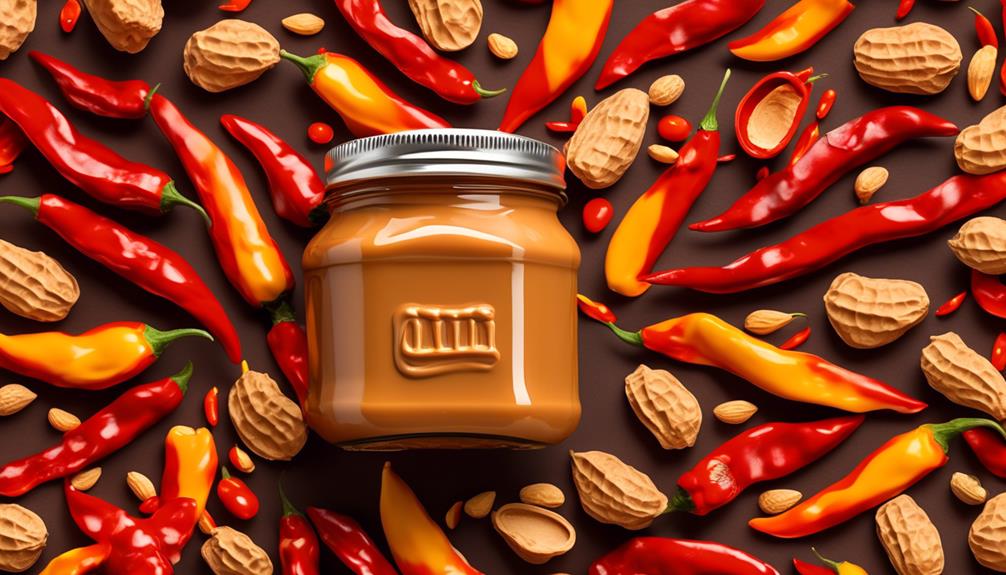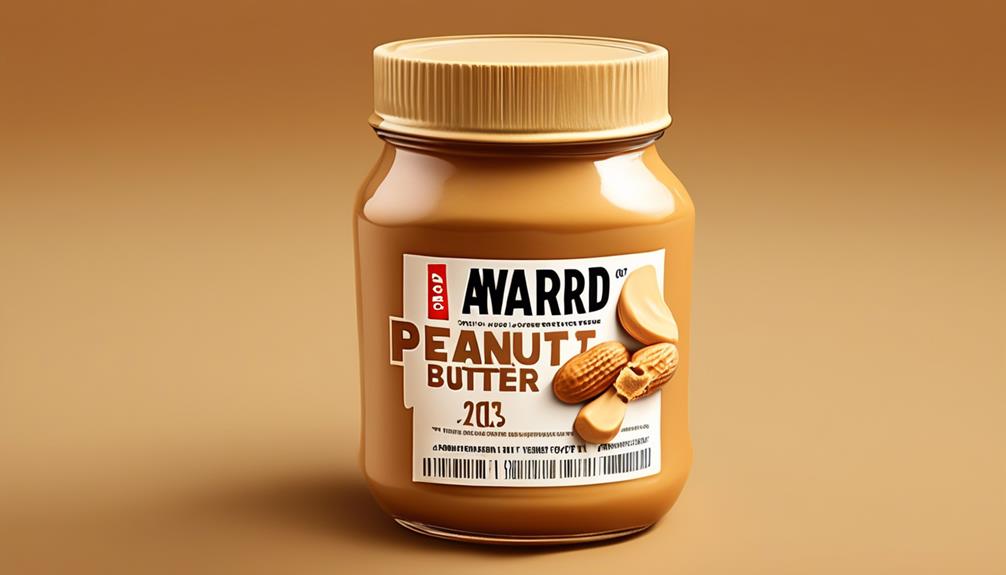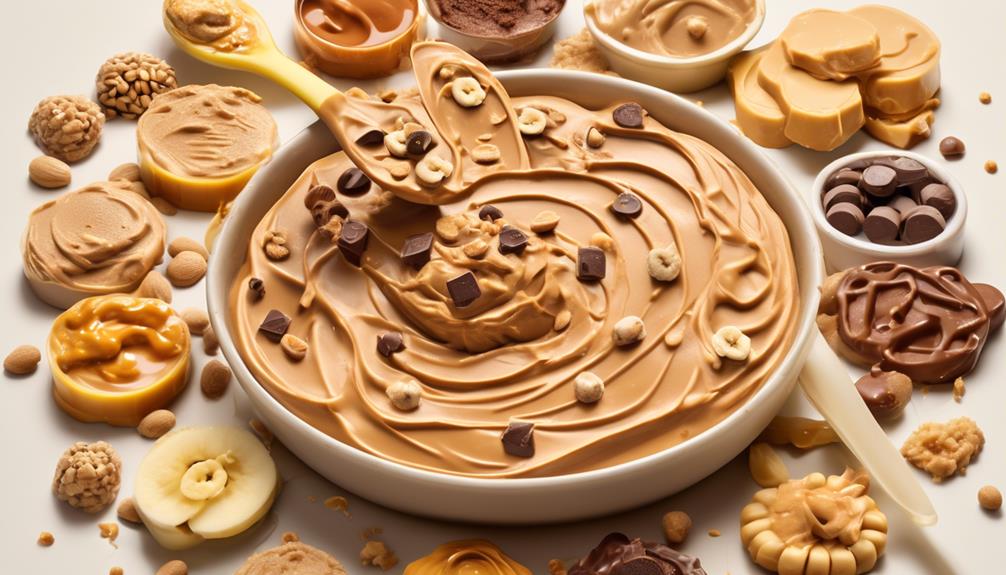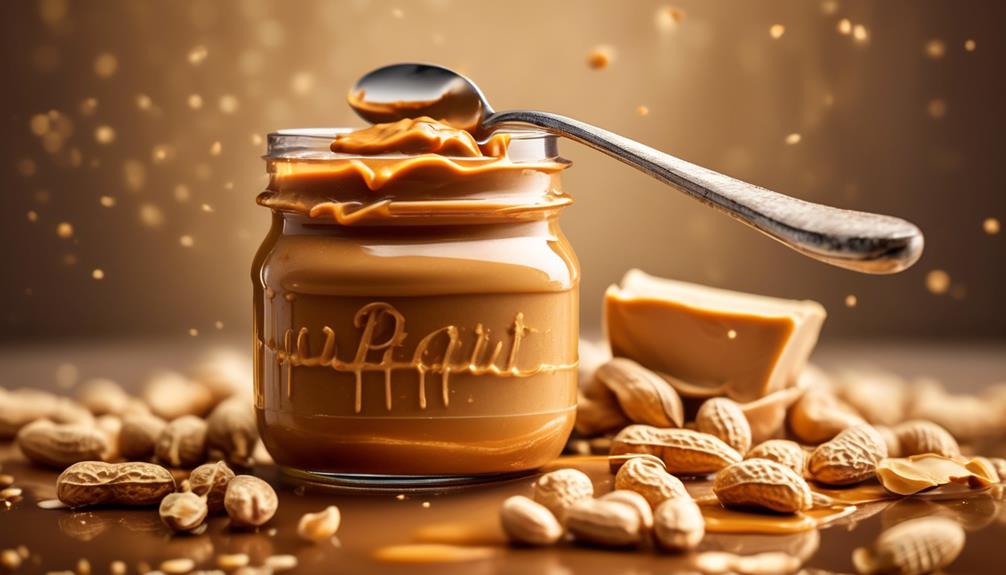It is truly interesting how just a basic name can cause so much confusion.
We've all grown up calling it peanut butter, but have you ever stopped to wonder why it's called that when there's no butter involved?
The answer might surprise you, and it sheds light on the intriguing history and evolution of this beloved spread.
Key Takeaways
- Peanut butter got its name because it was originally intended to be a non-dairy product resembling butter.
- The popularity of peanut butter in North America was influenced by factors like World War I rationing and the Great Depression.
- Peanuts are carefully inspected, shelled, and dry roasted before the grinding process, which releases natural oils for desired texture and flavor.
- Added ingredients like emulsifiers, sweeteners, stabilizers, and flavors are carefully selected to cater to diverse consumer preferences.
Origin and History
The origins and history of peanut butter can be traced back to ancient civilizations. While the Aztec and Inca civilizations are among the earliest to have mentioned peanut butter, it wasn't until 1884 that Marcellus Gilmore Edson obtained the first patent for a method of producing peanut butter. Subsequently, in 1898, peanut butter was officially invented as documented in US Patent #604493.
Contrary to popular belief, George Washington Carver didn't invent peanut butter; however, he played a pivotal role in promoting the use of peanuts and advocating for sustainable farming practices, significantly impacting the history of peanut butter. Additionally, the name ‘peanut butter' itself is indicative of its historical context, as the term ‘butter' was traditionally reserved for dairy butter, leading to the use of ‘butter' for non-dairy products.
The widespread popularity of peanut butter in North America was further influenced by various factors. Meat rationing during World War I and innovations in manufacturing played a role in its rise to popularity. Additionally, its association with childhood food during the Great Depression contributed to its widespread appeal. Notably, Joseph Rosefield's process of creating a smoother, creamier peanut butter also contributed to its popularity.
Production Process

When it comes to the production process of peanut butter, there are several key points to consider.
First, the selection of peanuts is crucial, as the quality and flavor of the final product depend on this initial step.
Next, the grinding process is a vital stage, as it determines the texture and consistency of the peanut butter.
Peanut Selection
Upon the completion of the peanut harvest in late August to October, the harvested peanuts are carefully transported to a peanut shelling machine for drying, initiating the crucial first step in the production process.
The peanut selection process is vital to ensure high-quality peanuts for the production of peanut butter, a staple in many households for making delicious butter and jelly sandwiches. In this phase, the peanuts are meticulously inspected and screened for contaminants to guarantee the purity of the final product.
The careful shelling of the peanuts is essential to avoid damaging the seeds, which are then dry roasted in either a batch or continuous method. This meticulous selection process ensures that only the best peanuts are used to create the creamy, flavorful peanut butter loved by many.
Grinding Process
After carefully selecting and drying the peanuts, we initiate the peanut butter production process by undergoing the essential grinding stage. The grinding process is a critical step in peanut butter production, as it involves finely crushing the peanuts to form a smooth and creamy paste.
This process releases the natural oils present in the peanuts, which are essential for creating the desired texture and flavor of the peanut butter. The use of industrial equipment, such as colloid mills or homogenizers, facilitates the grinding process, ensuring that the peanuts are ground to the perfect consistency.
Temperature control during grinding is meticulously managed to prevent overheating, preserving the flavor and nutritional quality of the peanut butter. Ultimately, the grinding process directly influences the texture, viscosity, and spreadability of the final peanut butter product, delivering the creamy delight that John Harvey Kellogg introduced to the world.
Added Ingredients
The incorporation of additional ingredients, such as sugar, salt, and hydrogenated vegetable oils, plays a crucial role in enhancing the flavor and texture of peanut butter during the production process. In the United States, where peanut butter is a staple, added ingredients are carefully selected to cater to diverse consumer preferences and enhance the overall product quality.
Some key added ingredients include:
- Emulsifiers: These are added to prevent oil separation and improve spreadability.
- Sweeteners: Varieties may contain honey, molasses, or other sweeteners to create different flavor profiles.
- Stabilizers and preservatives: Commercial brands may incorporate these to extend shelf life and maintain consistency.
- Flavorings: Certain types of peanut butter may contain added flavors such as chocolate or cinnamon to appeal to a wide range of tastes.
Consumption and Health Benefits

We've seen that peanut butter packs a punch when it comes to nutritional value, boasting a good mix of protein, healthy fats, and essential nutrients like magnesium and potassium.
However, it's important to note that peanut butter can also pose potential health risks, especially for those with peanut allergies.
As consumption of peanut butter continues to rise, it's crucial to weigh its benefits against the risks and ensure that its production and usage take into account these factors.
Nutritional Value
With its rich protein content and beneficial monounsaturated fats, peanut butter offers a valuable nutritional profile that supports heart health and provides essential building blocks for the body. When it comes to nutritional value, peanut butter truly stands out. Here are a few reasons why we love it:
- It's a fantastic source of protein, giving us the energy we need for our daily activities.
- The healthy fats, like monounsaturated fats, support our heart health, keeping us strong and thriving.
- With dietary fiber, peanut butter aids in digestion and promotes gut health, making us feel great from the inside out.
- It's convenient and energy-dense, providing a quick and sustained source of energy, perfect for those busy days.
Peanut butter truly is a nutritional powerhouse, providing essential nutrients and supporting our overall well-being. Joseph Lambert would be proud!
Potential Health Risks
Understanding the potential health risks associated with peanut butter consumption is crucial for individuals, particularly those with peanut allergies, as it can have serious implications for their well-being. Peanut butter can trigger severe allergic reactions, such as anaphylaxis, in those with peanut allergies, leading to symptoms like shortness of breath, wheezing, itching, and digestive problems.
Consequently, some schools have banned peanut butter and other allergenic foods due to allergy concerns. These restrictions highlight the significant health considerations associated with peanut allergies.
Given the modern prevalence of peanut butter in various food products, it's essential for individuals to be mindful of potential allergens and seek information from reputable health care sources like the Centers for Disease Control and Prevention and Mayo Clinic to ensure their safety and well-being.
Uses and Applications

Peanut butter's versatility extends beyond being a simple spread, finding applications in a wide range of culinary and non-culinary uses. This beloved spread isn't just for sandwiches; it's a staple in many households and food industries for various reasons.
Here are some remarkable uses and applications of peanut butter:
- Baking: Peanut butter is used to make delectable cookies, brownies, and cakes, adding a rich and nutty flavor to baked goods.
- Dog Treats: It can be used as a filling in food puzzle toys for dogs, providing them with a tasty and interactive treat.
- Snacks: A classic snack, 'Ants on a Log,' involves filling celery sticks with peanut butter and topping them with raisins, making for a delicious and nutritious treat.
- Humanitarian Aid: In humanitarian efforts, peanut butter has been used to combat hunger due to its high nutritional value and long shelf life.
Food scientists continue to explore new applications for peanut butter, showcasing its adaptability and potential beyond being just a spread.
The uses of peanut butter continue to evolve, making it an indispensable ingredient in various culinary and non-culinary settings.
Nutritional Profile

Rich in essential nutrients and healthy fats, peanut butter offers a valuable contribution to a balanced and nutritious diet. It's a good source of protein, providing around 7-8 grams per 2-tablespoon serving.
The healthy fats in peanut butter, including monounsaturated fats, support heart health and can help lower bad cholesterol levels. Additionally, it contains important nutrients such as magnesium, potassium, and folate, which are essential for various bodily functions.
Peanut butter is also rich in dietary fiber, promoting digestive health and providing a feeling of fullness. Moreover, it's a convenient and energy-dense food, making it a popular choice for a quick and satisfying snack or meal.
For those with allergies or seeking variety, nut butters like almond butter offer similar nutritional benefits. However, it's important to consume peanut butter in moderation due to its calorie density, especially for individuals monitoring their caloric intake.
Allergies and Risks

Due to the potential for allergic reactions, particularly among those with peanut allergies, it's important to be aware of the risks associated with consuming peanut butter and other peanut products. As someone who loves peanut butter, it's crucial to understand the potential dangers and take necessary precautions. Here are some key points to consider:
- Always read labels carefully: Peanut butter can sometimes be an unexpected ingredient in various food products, so it's essential to carefully read labels to avoid accidental consumption.
- Cross-contamination: Many facilities process peanuts and other allergens, increasing the risk of cross-contamination. Look for products that are specifically labeled as 'peanut-free' to minimize this risk.
- Educate those around you: Whether it's family, friends, or coworkers, it's important to communicate your allergy and ensure they understand the severity of the situation.
- Emergency preparedness: For individuals with severe peanut allergies, carrying an epinephrine auto-injector at all times is critical in case of accidental exposure.
Being mindful of these risks doesn't mean giving up peanut butter entirely, but it does involve being cautious and well-prepared to enjoy it safely. Especially during events like Meatless Mondays, when peanut butter might be used as a protein substitute, it's important to be extra vigilant.
Rheological Properties

Studying the rheological properties of peanut butter provides valuable insights into how this popular spread behaves under different conditions and influences its overall quality and stability.
Viscosity, the resistance to flow, and texture are crucial rheological properties that significantly impact the overall peanut butter experience. These properties determine how the peanut butter spreads, feels in the mouth, and holds its form, influencing its suitability for uses like the classic peanut butter and jelly sandwich.
Additionally, understanding these properties is essential for optimizing the manufacturing processes, ensuring that the peanut butter has the desired texture and spreadability. Rheological studies also explore the impact of factors such as grinding time and stabilizer content on the texture and storage stability of peanut butter, providing important insights for manufacturers to enhance product quality and shelf life.
This knowledge became particularly crucial during World War II when peanut butter was a staple food for soldiers due to its high nutritional value. Even today, on National Peanut Butter Day, these rheological properties continue to play a vital role in maintaining the quality and consistency of this beloved spread.
Frequently Asked Questions
Why Do We Call It Peanut Butter?
We call it peanut butter because it follows a traditional naming convention for spreads made from nuts, even though it doesn't contain any dairy or butter. The name 'peanut butter' reflects historical influence and convention. It's a workaround to avoid using the protected term 'butter' for non-dairy products.
In some languages, like Dutch, peanut butter is called 'pindakaas,' which translates to 'peanut cheese'. The term 'nut butter' is used for other nut-based spreads.
What Would Peanut Butter Be Called if It Wasn T Peanut Butter?
If it wasn't called peanut butter, it might've been named 'nut spread' or 'oily nut paste'. This could have reflected its texture and consistency. Other suggestions like 'peanut cream' or 'peanut jizz' were also considered.
But the name 'peanut butter' stuck due to dairy butter regulations. It's fascinating how alternate names could have given peanut butter a different identity, yet it's the familiar name that has stood the test of time.
Why Is It Called Peanut Butter and Not Peanut Paste?
We call it peanut butter instead of peanut paste because the term 'butter' was historically used for dairy products only. So when people started making a spreadable paste from peanuts, they adopted the term 'butter' to reflect its similar consistency to dairy butter.
It's a nod to tradition, but the name might be a bit misleading. Nonetheless, the term has stuck, and it's what we've come to know and love.
Did Peanut Butter Have Butter in It?
No, peanut butter doesn't contain actual butter. It's made by grinding roasted peanuts into a spreadable paste with a creamy texture, resembling butter.
The term 'butter' was used to describe this consistency, even though it lacks dairy butter. This distinction from other nut butters, like almond or cashew, solidified the name 'peanut butter.'
Its historical context and widespread usage have cemented its conventionally accepted name, despite not containing dairy butter.
Conclusion
In conclusion, peanut butter is a versatile and nutritious spread that has become a staple in many households. Its rich history, production process, health benefits, and wide range of uses make it a truly remarkable food product.
Despite the misleading name, peanut butter is not actually a dairy product. It is made from ground peanuts and sometimes includes additional ingredients like oil, sugar, and salt. The production process involves roasting the peanuts, grinding them into a paste, and adding any desired additives.
Peanut butter is not only delicious but also packed with nutrients. It is a good source of protein, healthy fats, fiber, and various vitamins and minerals. It has been linked to several health benefits, including improved heart health and reduced risk of certain diseases.
Furthermore, peanut butter is incredibly versatile and can be used in a wide range of dishes. It can be enjoyed on its own as a spread or as an ingredient in sandwiches, smoothies, baked goods, sauces, and dressings. The possibilities are endless.
So, while it may not actually contain any butter, there's no denying that peanut butter is truly in a league of its own. It is a beloved food that has earned its place in pantries around the world.









